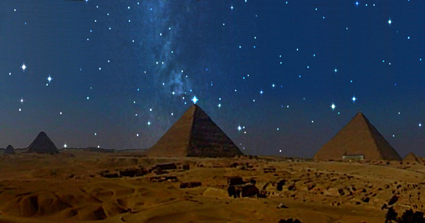
Great Pyramid Slope By Compass/Rule Construction
- May 18, 2016
- 0
by Michael Donovan
With the help of a little drawing program called Stella, you can construct a pyramid by simple geometric compass and rule! Just follow these instructions…
All prior angles of slope attributed to the Great Pyramid were either archaeological guesses from the eroded structure itself or from the assumption attributed as being passed by Egyptian priests to Heroditus that the square of the height was equal to the area of a side. From the structure itself the slope is usually seen as less than 52 degrees and over 51.5 degrees. One calculation from the height-squared=s-area-of side is 51.84444~ (Given by Taylor).
Because the differences in angle are so small the problem had to be solved first and worked back so that with a CAD or drawing program the angle can be seen. It requires some exactness and much zooming in and out. And this also more easily accomplished with using small units such as pixels so fractions would not be involved. Here is the angle: Construct a vertical line with a height that is easily divided by six, such as 60,000 pixels. Construct one 60 degree and one 120 degree through the very top of the first line. Construct also a line at the bottom of, and horizontal to, the first vertical line of 60,000 pixels. Here for accuracy guidelines should be used. And with ‘snap-to-guides’ an upright equilateral triangle formed which would have the top of that first 60,000 pixel line as apex and the intersections of where the constructed 60 and 120 degree angles crossed the line horizontal to the base of that first line.
Construct a circle with the top of the triangle as center and the circumference going through the other two sides. Do as accurate as possible, but at the end adjust the differences so that the intersection of the bottom left corner of the triangle and the circumference is the most accurate. Next, as you wish to measure with a circle 1/6th of the original line (10,000 pixels); construct a circle with that radius. Having done this many times in a drawing program let me make this suggestion: Construct with guideline a square of exactly 1/3rd the first line as the sides (20,000 by 20,000 pixels).
Using circle tool and snap-to-guides construct the circle within that would have the 10,000 radius. Zoom to the center and carefully use guidelines and create little cross-hairs that can be grouped with this circle and moved with it. Using these cross-hairs move the circle so that the center sits over the bottom left corner of the triangle that is intersected by the circumference of the larger circle. Using intersecting guidelines to snap to, snap a line between where the smaller circle intersects the larger circle (to the left) and the apex of the triangle. You should get about 51.73 degrees.
Is this some lucky or coincidental construction of angles, or something those interested in the Great Pyramid should consider? After all, if you divide 360 degrees by seven you get 51.43857~. That can be reasoned a tad too small, but other types of constructions could be composted until one hits, without reason, somewhere between 51.5 and 52 degrees.
The angle constructed came from a long study of spherepacking with concentration on one of the two manners in which 12 balls fit around one. Of the two ways in which 12 balls can fit around one this is the odd one. By which to say that it is not, for example, the way in which cannon balls pile. If 12 balls are extending around in this ‘other manner’ the centers of the outside balls, (packed close around a center ball), would form a cubeoctohedron. This is a regular 3-D solid with 14 sides. Eight of these sides are tetrahedrons and six of the sides are squares. And, of course, the sides of the six squares and the sides of the eight tetrahedrons are all equal. The squares are in three pairs across from each other. Imagine what would happen if you took the sides of any of the outside squares and moved them across the edge and into the eight triangles so that the triangles disappear.
First you must see the cubeoctohedron as composed of eight tetrahedrons and six pyramids. The question then becomes how far must each of the sides of the squares, (the bases of the pyramids), move to ‘disappear ‘ the triangles remembering that these triangles are the uter bases of the eight tetrahedrons. At first blush one might guess 1/3 the height of one of the tetrahedron bases. However, with some better visualization of the problem, you will see that as you move one edge, you move the edge on the other side.
In the construction the equilateral triangle is two different things. It is the side of one of the pyramids tilted toward you so that it is flush. But the height first measured is also the distance across, from a side to top, of the bottom of one of the eight tetrahedrons. In this case the shape and size of the sides of the six pyramids (all of 60 degree angle slopes), and the outside surface of the eight tetrahedrons are all the same. Or to rephrase, being the same you used the same equilateral triangle to construct both the equilateral triangle the side of the pyramid was moving across and the side of the original 60 degree slope pyramid. Therefore, the small circle you constructed measures how much the outside edge must move. And this decreases the angle of slope of the pyramid (of all six) to about 51,73~.
For the sake of discussion you might also construct 51 degree and 52 degree guidelines. And put a line for Taylor’s 51.84444~ degree also. Let us assume that that the 51.84444~ is the same concept from a sphere, not cubeoctohedron. This is visual reasonable noticing how 51.8444 weaves on bo th sides. And a further bisecting could logically go there. The question now would be which angle was the construction of the Great Pyramid. The situation is similar to Kepler’s reflection upon the Spheres formed by Platonic solids and the orbits of planets. The aesthetics of the spheres were not panning out. But that led him to greater realizations and the Laws of Planetary Motion.
There are some preliminary indications that the specific 12 around one pattern of balls that produces the cubeoctohedron and the 51.73~ is also related to other strong limits of nature, the limit of four forces, the limit of 12 quarks, and the confusing limit of 230 crystal symmetry conditions. We do know that the general pyramid shape can produce with some rigor some anomalous oddities of physics such as re-sharpening the older type razor blades with greater iron content. In very loose terms, if the builders were onto an inner design of physics, it would point toward the 51.73~. If pure aesthetics, 51.84~. Though I would hope the former, only because it could eventually cause more amazement. But certainly it is one or the other. And both can be shown to be constructed by simple geometric compass and rule.
(Note: There is a very small and easy to use program called Stella. A free demonstration copy of Stella downloads in just a minute or two, and is at; http://www.software3d.com/downloads.html . This little gem of a program makes it easier to see the 1/6th move that some people have had trouble visualizing. Cuboctahedron is under Archimedean. This is produced when the centers of the 12 balls that are around one are connected, 14 surfaces. You can twist this around and look at it. With the mouse you can roll the construction in any direction or click to stop. As user friendly as playing catch.
Although it is not doing the same movement, you can also get a concept, (though not doing the exact motion) by holding down shift and control at the same time and operating the mouse.
Under Archimedean there is also the truncated tetrahedron. This also with control/shift can be manipulated with the mouse to create a shape where you can see towards the center from the 14 holes made by the six pyramids and eight tetrahedrons which here have their bases off.
Again, though the motion of the planes is not what I describe above (in these surfaces move toward, away from, and through center), it does help visualize.
Michael Donovan’s website is: www.midcoast.com/~michael1



